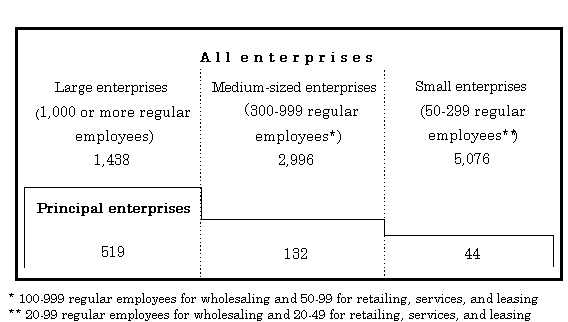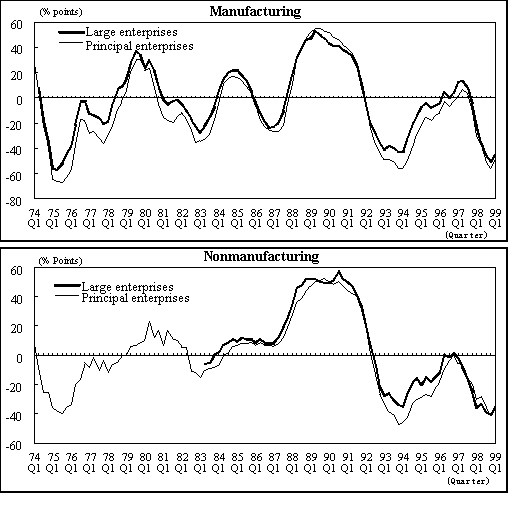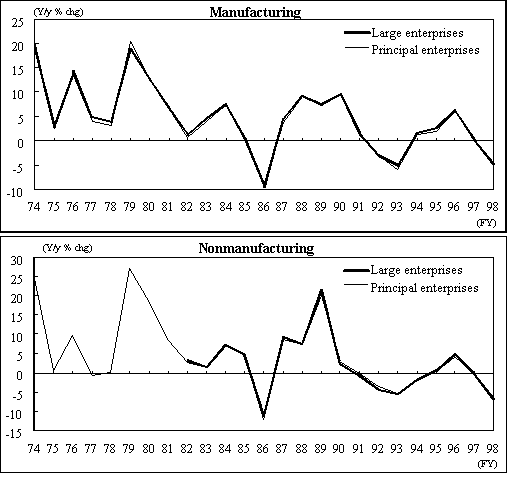Revision of "the Short-term Economic Survey of Enterprises in Japan (Tankan)"
December 24, 1998
Bank of Japan
Research and Statistics Department
"The Short-term Economic Survey of Enterprises in Japan (Tankan, an abbreviation of Tanki Keizai Kansoku Chousa)" consists of two different surveys: the "Principal Enterprises Tankan," which surveys approximately 700 principal enterprises, and the "All Enterprises Tankan," which compiles the responses of almost 10,000 enterprises nationwide. The sample enterprises of the "All Enterprises Tankan" are revised once every five years and fiscal year 1998 is the next revision period.
In addition to this regular revision of the sample enterprises, this time we are also implementing a statistical revision of the "All Enterprises Tankan." Both revisions will be effective from the upcoming March 1999 survey, to be released at the beginning of April. The main points of the revisions are summarized as follows:
1. Revision of the "All Enterprises Tankan"
Regular revision
The "All Enterprises Tankan" is a sample survey. The population of the survey is approximately 160,000 private enterprises, excluding financial institutions, with 50 or more regular employees (20 or more regular employees for the wholesaling, retailing, service and leasing industries) based on the Establishment and Enterprise Census of Japan released by the Management and Coordination Agency. Subject to the 1996 revision of this Census, released in 1997, we are going to revise the sample enterprises for the "All Enterprises Tankan" from the upcoming March 1999 survey. This is the first regular revision since the previous sample revision conducted for the November 1993 survey.
After this revision, the number of sample enterprises for the March 1999 survey will be 9,510, compared to 9,129 for the December 1998 survey. A total of 1,094 new enterprises will be added, while 713 enterprises sampled in the December survey will be omitted (Tables 1 and 2).
The present revision is designed to capture more accurate trends of nationwide corporate activities by industry and scale while minimizing the number of sample enterprises. This improvement owes much to the more detailed information on population enterprises, i.e. the number of employees of individual enterprises, which can be obtained from the 1996 Establishment and Enterprise Census of Japan. Please refer to the appendix for a detailed explanation of the revisions to the survey sample.
Statistical revision
- 1) The new survey items will include the nominal yen-denominated figures for the population estimates for sales, profits, fixed investment, and other items. Previously, only ratios, such as year-to-year growth rates, the ratio of current profits to sales, and adjusting ratios versus previous survey, have been released.
- 2) All items related to current profits, overseas production and investment, and hiring of new graduates will now be based on population estimates, just like the other survey items. Previously, the figures presented were simple aggregates of the sample enterprises. However, items for judgemental surveys, such as the Business Conditions Diffusion Index, will continue to be simple aggregates of the sample enterprises.
- 3) The adjustment ratios versus the previous survey will now be calculated as the ratio between the population estimates of the present and previous surveys, based on all enterprises responding to each survey, the number of which may differ between the two surveys. Previously, the adjustment ratios were calculated based only on enterprises responding to the two consecutive surveys.
Discontinuity between pre- and post-revision data, and scheduled release
As a result of this revision, there will be no continuity between the figures of the "All Enterprises Tankan" of December 1998 and March 1999 surveys. For your convenience, at the timing of the December survey, we are collecting and aggregating prior figures for the new sample enterprises, and a comparison of population estimates between the old and new samples will be disclosed prior to releasing the March 1999 survey. Comparison for items in judgemental surveys, such as the Business Conditions DI, will be limited to the December 1998 survey. Please note that figures in the March 1999 survey will not be comparable to pre-revision data due to the differences in sample enterprises and calculation methods.
2. Utilizing the "All Enterprises Tankan" in comparing data by scale
We will continue to release the data of the "Principal Enterprises Tankan."1 However, in comparing data by scale of enterprises, we will utilize the whole data set of the "All Enterprises Tankan" instead of comparing the data from the "Principal Enterprises Tankan" with those for small enterprises from the "All Enterprises Tankan," taking account of the following issues with the "Principal Enterprises Tankan."
The surveyed enterprises of the "Principal Enterprises Tankan" have changed little since this survey was initiated in 1959.2 Hence, the "Principal Enterprises Tankan," with essentially fixed survey enterprises for such a long period, is useful for time-series analyses, but it may diverge from the current corporate activities.
The concept of "principal enterprises" is ambiguous. For example, "principal enterprises" include some enterprises that should be categorized as small enterprises with respect to the number of employees.
All surveyed enterprises of the "Principal Enterprises Tankan" are included in the sample enterprises of the "All Enterprises Tankan" and the coverage of the "Principal Enterprises Tankan" is smaller than that of the "All Enterprises Tankan". The previous results of the "Principal Enterprises Tankan" were basically the same as those of "large enterprises" in the "All Enterprises Tankan" (Table 3 and Chart 1).
- No revision will be made to the "Principal Enterprises Tankan" except some change of industry classification for a few enterprises.
- The sample definition of "Principal Enterprises" in Tankan is "large enterprises capitalized at 1 billion yen or more, mostly listed on stock exchanges, reflecting the trends of their respective industries."
3. Change of release format
In addition to the above revisions, we will also change the release format of Tankan materials3 starting from the upcoming March 1999 survey. Detailed information on these editorial changes will be released in the near future together with reference tables providing comparison between the figures of the "All Enterprises Tankan" of the old and new samples.
We are planning to publish more technical notes on the present revision following the release of the results of the March 1999 survey. For any further inquiries, please contact:
Economic Statistics Division,
- Mr. Chihiro Sakuraba
- E-mail address: chihiro.sakuraba@boj.or.jp
- Mr. Kiyohito Utsunomiya
- E-mail address: kiyohito.utsunomiya@boj.or.jp
- 3The regular Tankan materials include the "Tankan Summary" and "Tankan Outline," both of which are published on the Tankan release date, and the "Tankan Report: Short-term Economic Survey of Enterprises in Japan," which is published three weeks later. Please note that the English version of "Tankan Report" will be released in a single volume with the Japanese version from the March 1999 survey.
Appendix: On Revising the Survey Sample for the "All Enterprises Tankan"
The "All Enterprises Tankan" is a sample survey, the population of which is approximately 160,000 private enterprises, excluding financial institutions, with 50 or more regular employees (20 or more regular employees for the wholesaling, retailing, service and leasing industries) based on the Establishment and Enterprise Census of Japan, which is released once every five years by the Management and Coordination Agency.
For revising our population sample, we adopted a stratified sampling method, dividing the population into 27 industries and 4 to 6 scales, and selecting sample enterprises from each stratum. We reviewed the previous sample in light of data from the 1996 Establishment and Enterprise Census of Japan. The sampling procedure and results are as follows:
- 1) Enterprises included in the previous sample were retained with only a few exceptions.
According to statistical theory, it is preferable to select at random all sample enterprises from each industry and scale stratum for every sampling. However, randomly sampling almost 10,000 enterprises for each revision entails a large burden in asking new qualified enterprises to cooperate with our survey and conducting preliminary research in order to retrospect past data.
To minimize the statistical compilation burden and maximize the accuracy of the survey, the enterprises included in the previous sample were retained except for those already disqualified for the new population, for example, for not satisfying the requirement of the minimum number of regular employees. - 2) We enhanced the accuracy of the survey and limited the number of sample enterprises simultaneously by strictly applying statistical methods.
For the sample enterprises selected in 1), above, we verified the following two points in order to obtain statistical accuracy equivalent to that from overall random sampling.- a) The distribution of the sample enterprises is not significantly different from the distribution of the population.
- b) The standard error of the population estimate of sales should be small.
Based on the verification results, we increased the number of sample enterprises of some strata in order to meet the target error (the additional sample enterprises were selected via random sampling), and successfully enhanced the accuracy of the survey and limited the number of sample enterprises simultaneously.
- 4In order to test the difference between the distribution of the sample enterprises and the population, we conducted an
 -square test of fitness against the number of employees based on the 1996 Establishment and Enterprise Census of Japan.
-square test of fitness against the number of employees based on the 1996 Establishment and Enterprise Census of Japan. - 5In general, the standard error of the population estimate declines as the sample number increases. Thus, it is essential to maximize both the efficiency of the survey and the accuracy of the statistics. For the present revision, we set the same target for the standard error adopted in the previous revision which is 3 percent for each scale of the manufacturing sector and 5 percent for each scale of the non-manufacturing sector on a sales basis. The standard errors were calculated from sales data in the Results of the Basic Survey of Japanese Business Structure and Activities 1996 and the Census of Commerce 1994, both released by the Ministry of International Trade and Industry, and other statistics.
(Table 1) Number of Population/Sample Enterprises after the Revision (Planned)
| Total | |||||||||
|---|---|---|---|---|---|---|---|---|---|
| Large enterprises | Medium-sized enterprises |
Small enterprises | |||||||
| Population | Sample | Population | Sample | Population | Sample | Population | Sample | ||
| All industries | 160,002 | 9,510 | 2,715 | 1,438 | 38,735 | 2,996 | 118,552 | 5,076 | |
| Manufacturing | 31,405 | 3,949 | 1,078 | 782 | 3,114 | 1,119 | 27,213 | 2,048 | |
| Textiles | 3,206 | 303 | 42 | 30 | 180 | 49 | 2,984 | 224 | |
| Lumber & Wood products | 1,073 | 121 | 12 | 10 | 68 | 27 | 993 | 84 | |
| Pulp & Paper | 954 | 131 | 18 | 16 | 78 | 34 | 858 | 81 | |
| Chemicals | 1,221 | 268 | 113 | 87 | 204 | 73 | 904 | 108 | |
| Petroleum & Coal products |
79 | 42 | 10 | 10 | 19 | 12 | 50 | 20 | |
| Ceramics | 1,320 | 199 | 28 | 23 | 108 | 48 | 1,184 | 128 | |
| Iron & Steel | 675 | 152 | 30 | 29 | 78 | 42 | 567 | 81 | |
| Nonferrous metals |
522 | 113 | 24 | 21 | 55 | 25 | 443 | 67 | |
| Food & Beverages |
4,329 | 455 | 124 | 84 | 418 | 134 | 3,787 | 237 | |
| Processed metals |
2,355 | 246 | 43 | 31 | 190 | 75 | 2,122 | 140 | |
| Industrial machinery |
3,334 | 479 | 101 | 80 | 325 | 133 | 2,908 | 266 | |
| Electrical machinery |
4,792 | 657 | 251 | 165 | 622 | 248 | 3,919 | 244 | |
| Shipbuilding & Heavy machinery |
231 | 69 | 10 | 10 | 21 | 13 | 200 | 46 | |
| Motor vehicles | 1,695 | 279 | 127 | 98 | 217 | 80 | 1,351 | 101 | |
| Other transportation machinery |
236 | 48 | 9 | 8 | 27 | 13 | 200 | 27 | |
| Precision machinery |
758 | 128 | 35 | 27 | 95 | 31 | 628 | 70 | |
| Other manufacturing |
4,625 | 259 | 101 | 53 | 409 | 82 | 4,115 | 124 | |
| Manufacturing | 128,597 | 5,561 | 1,637 | 656 | 35,621 | 1,877 | 91,339 | 3,028 | |
| Construction | 9,135 | 719 | 201 | 107 | 526 | 80 | 8,408 | 532 | |
| Real estate | 1,199 | 197 | 26 | 12 | 116 | 25 | 1,057 | 160 | |
| Wholesaling | 32,986 | 1,362 | 257 | 83 | 5,784 | 309 | 26,945 | 970 | |
| Retailing | 31,550 | 1,161 | 399 | 174 | 10,550 | 655 | 20,601 | 332 | |
| Transportation | 9,237 | 693 | 200 | 115 | 786 | 113 | 8,251 | 465 | |
| Communication | 155 | 43 | 14 | 9 | 36 | 13 | 105 | 21 | |
| Electric & Gas utilities | 130 | 52 | 18 | 17 | 12 | 10 | 100 | 25 | |
| Services | 42,956 | 1,157 | 506 | 125 | 17,413 | 609 | 25,037 | 423 | |
| Leasing | 1,125 | 145 | 11 | 10 | 388 | 55 | 726 | 80 | |
| Other nonmanufacturing | 124 | 32 | 5 | 4 | 10 | 8 | 109 | 20 | |
(Table 2) Number of Sample Enterprises in the Past Revisions
| Number of sample enterprises |
|
|---|---|
| Start of survey (May 74) | 5,596 |
| First revision (May 80) | 5,373 |
| Second revision (May 83) | 7,035 |
| Third revision (Feb. 85) | 7,116 |
| Fourth revision (May 85) | 7,635 |
| Fifth revision (Nov. 93) | 10,011 |
| Sixth revision (Mar. 99) | 9,510 (planned) |
(Table 3) Number of Sample Enterprises for "All enterprises" and "Principal enterprises" (Planned)
All eterprises: 9,510 (Manufacturing: 3,949, Nonmanufacturing: 5,561)
Principal enterprises: 695 (Manufacturing: 383, Nonmanufacturing: 312)
(Chart 1) Comparison between "Large enterprises" and "Principal enterprises" on
Business Conditions DI and Sales
(1) Business Conditions DI
(2) Sales
Note: Values in FY 98 are forecasted at the December 98 Survey



